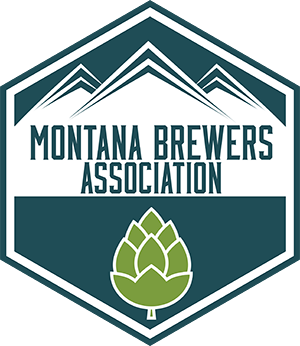

Montana brewers, hops growers and maltsters are teaming up to produce the Last Best Pale Ale. It is a Montana craft beer made entirely with Montana grown hops and malt to celebrate Montana’s tastiest industry while raising money for the brewers’ state association.
The Last Best Pale Ale was conceived this winter as a way to bring brewers together doing what they do best – brewing great beer.
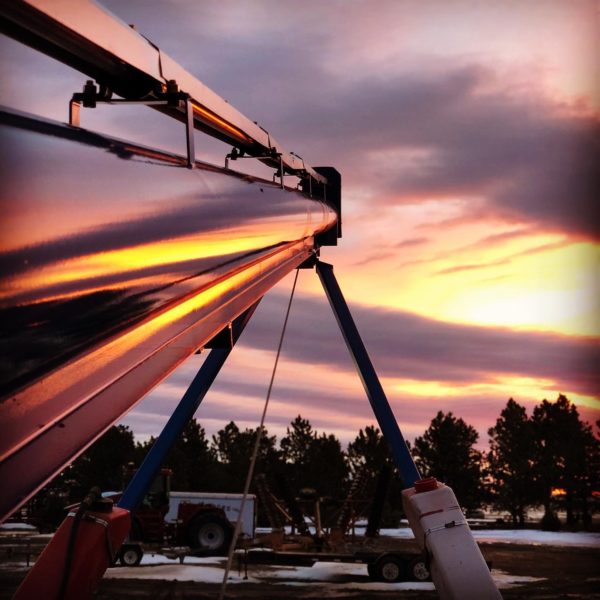
Golden Triangle picked up malt barley directly from the farm.
“It has been a long, hard 12 months for all of us. One of the most fun parts of our jobs is getting together at brewfests and different industry events to have a good time with other brewers and craft beer lovers. We miss that. This project is a really cool way to do something collaboratively that is fun for us and the public. I think we can all agree that we need things like that right now,” said Ethan Kohoutek, co-owner of Ten Mile Creek Brewing and president of the MBA.
The Last Best Pale Ale is a collaboration of MBA member breweries, but the recipe leaves a lot of room for interpretation and creativity. Brewers are using “C” hops from Crooked Yard Hops, Hopzoil from Glacier Hops Ranch, and pale and crystal malts provided by Farm Power Malt, Gallatin Valley Malt, Malteurop and Montana Craft Malt. Beyond those simple guidelines, brewers are free to put their own unique spin on it.
Golden Triangle Brew Co. in Ft. Benton is using a new malt barley variety from the MSU barley breeding program for their take on the Last Best Pale Ale. In fact, Golden Triangle owner Brandon Roberts went directly to the farm to pick up the new Buzz malt barley.
“Early one morning, we hooked the auger up to the bin and hauled approximately 60 bushels of this barley to Ryan Pfeifle with Farm Power Malt, and he custom malted it for us,” said Roberts. “Our Last Best Pale Ale will be a SMaSH (single malt and single hops) with our custom Buzz barley.”
The MBA is pleased by the involvement of local suppliers, making the Last Best Pale Ale a true Montana brewing collaboration. This beer brings together farmers, maltsters, hop growers and brewers to produce a uniquely Montana beer.
“This is exactly the kind of collaboration and partnership that speaks to us, because it perfectly aligns with our mission to celebrate both Montana agriculture and the craft brewing community here,” said Jen O’Brien, president and founder of Montana Craft Malt. “We’re always excited about an opportunity to collaborate with our Montana growers, brewers, and fellow Montana malt producers, because this growing and incredibly important community is one that we actively want to help continue to build in any way that we can.”
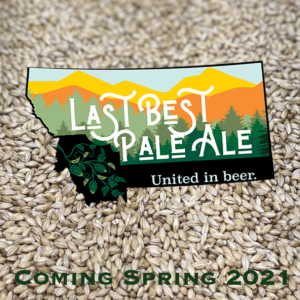 Nineteen Montana breweries are brewing the Last Best Pale Ale in preparation for the March 20 release. The beer can be found at participating breweries for pint, growler and crowler sales. A portion of the sale of each pint, growler or crowler will go to support the MBA.
Nineteen Montana breweries are brewing the Last Best Pale Ale in preparation for the March 20 release. The beer can be found at participating breweries for pint, growler and crowler sales. A portion of the sale of each pint, growler or crowler will go to support the MBA.
“Spring is a time of renewal and hope, so we thought the first day of spring, especially given the challenges of the past year, would be a fitting time to put this special release on tap,” said Matt Leow, executive director of the Montana Brewers Association. “Please get out and support your local breweries while sampling brewers’ various takes on the Last Best Pale Ale.”
Find the Last Best Pale Ale at the following breweries starting March 20:
* On tap March 27
** On tap March 30
*** On tap March 31
We’re halfway through the 2021 Montana State Legislative Session, and three bills broadly supported by the Montana alcohol industry groups are moving right along. One has already passed and has been signed into law by Gov. Gianforte.
While policy debates about increased hours for brewery taprooms produce predictable controversy, there are bills that essentially everyone in the industry can get behind. The Montana Brewers Association has joined with other members of the Montana Alcohol Industry Coalition to support bills that clarify hard seltzers, kombuchas and other “malternatives” may be brewed under a Montana brewer license, make some of the temporary COVID rules for to-go drinks permanent, and reduce barriers for breweries engaging in a “closely held license.”
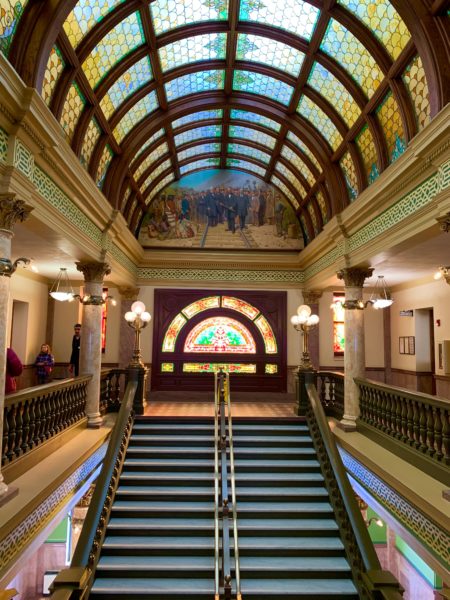
Barrel Vault over the Grand Stairway in the Montana State Capitol
HB 79, sponsored by Rep. Mark Noland (R-Bigfork), updates MT law to clarify that alternative malt beverages like hard seltzers and hard kombuchas may be produced under a brewery license. With the increased popularity among consumers and more Montana breweries producing these beverages, the Alcoholic Beverage Control Division of the Department of Revenue noticed the law was in need of an update.
The brewing world is evolving, and our laws need to adapt to keep up with these changes. HB 79 provides regulatory clarity for how breweries may produce alternative malt beverages. This sensible bill passed the House 95-5 and the Senate 44-5 on its way to the governor’s desk. Gov. Gianforte signed HB 79 into law on February 23, and the bill took effect immediately.
HB 226, sponsored by Rep. Katie Zolnikov (R-Billings), makes some of the temporary rules permanent, specifically curbside delivery for all on and off premises retailers, including manufacturers with limited retail privileges. During the early days of the pandemic, Gov. Bullock put in place temporary rules to permit businesses selling alcohol to make those transactions as a curbside sale, allowing the public to pick up a six-pack, growler or bottle of liquor without having to enter the business or even get out of their car. The original impetus was to protect public health while providing these businesses with an important way to make their sales during this challenging time, but the concept was popular with consumers and there is interest in making the rule permanent.
Beyond curbside sales, HB 226 also allows for bars, restaurants, breweries, distilleries and wineries to sell single-serving to-go drinks, allows beer and wine wholesalers to make dock sales of beer to licensed retailers, and fixes a problem with the legal definition of a growler. When the definition for growler was written into Montana law, crowlers were not yet a thing. Because of that, on-premises licensees such as bars, restaurants or brewery taprooms operating under a closely held license may sell beer to-go in growlers but not in crowlers. HB 226 broadens the definition of a growler to include crowlers, thereby removing the absurd restriction.
The House passed HB 226 on February 10 with a vote of 80-19. It will be heard by the Senate Business and Labor Committee on March 12.
HB 157, sponsored by Rep. Marshall (R-Hamilton), makes it a bit easier for a brewery to engage in a closely held license. Coalition partners have been referring to the proposal as “Light Reform.” A closely held license is the option currently available for brewers to expand retail privileges by working within the liquor license quota system to purchase a retail license and operate the brewery taproom under that license. Brewers and their immediate family are prohibited by law from owning a retail license, so in this scenario the brewery and the taproom become two separate businesses with completely separate ownership and books. Current law and rules require a permanent floor-to-ceiling wall separating the brewery from the taproom, which would be impractical and expensive for some breweries.
HB 157 removes some of the obstacles, literal and figurative, for breweries engaging in a closely held license by allowing the spouse of a brewer to hold the retail license and softening the required physical separation between the two businesses. The House passed HB 157 with a vote of 95-4. The bill will be heard by the Senate Business and Labor Committee on March 16.
Each of these bills represents a modest, yet meaningful change that was able to find support among all the various industry groups. The MBA will continue to work for more comprehensive reform, but in the meantime we also support smaller steps like these.
As the Montana Legislature approached its transmittal deadline of March 3, the date by which all general bills must pass the chamber of origin, the House Business and Labor Committee heard a bill to allow brewers to hold a retail license. This policy is often referred to as “license stacking” or simply “stacking.”

Montana State Capitol Rotunda
HB 534, sponsored by Rep. Ed Buttrey (R-Great Falls), would remove the restriction that prohibits brewers from holding a liquor license. That restriction, coupled with the quota system for liquor licenses which can make licenses expensive and/or hard to come by, has been the main source of policy friction between the MBA and the Montana Tavern Association (MTA). To put it simply, the MTA wants breweries to buy a license in order to gain additional retail privileges beyond the 48 ounce limit and hours restriction of 10 a.m. to 8 p.m., yet brewers are prohibited by Montana law from purchasing such licenses.
In each of the last several legislative sessions, bills to extend brewery hours (typically to allow taproom sales until 10 p.m.) have failed to even make it out of committee. While popular with brewers and consumers, additional hours for breweries has been a non-starter for every other industry group, save the other manufacturers. Groups representing taverns, restaurants, the gaming industry, distributors and liquor stores have all opposed those bills. In 2015, the MBA supported another bill very similar to HB 534. That bill also failed to make it out of committee with opposition coming from the distributors and even several breweries.
Much has changed since 2015, not the least of which is the move by many breweries to engage in a closely held license (see: Three Coalition Bills Progress Through the Legislature). Currently, 25 Montana breweries, about one-fourth of the industry, have converted their taprooms over to a closely held license. If you ever wondered how certain breweries are able to serve beer in their taprooms past 8 p.m., this is how.
However, a closely held license is not an option for some breweries, such as those that own their building, due to federal law that prohibits a manufacturer from renting to a retailer. It’s also out of reach for breweries with a complicated ownership structure. Stacking, which permits a brewer to also own a retail license, provides a cleaner solution.
Many of the fears and concerns raised in 2015 have not come to fruition as more breweries moved to closely held licenses as a solution. That is the most significant difference between the current situation and the proposal from six years ago. This time around, brewers were more united behind HB 534 and were joined by the Montana Tavern Association, Montana Restaurant Association, Montana Distillers Guild, Gaming Industry Association of Montana, and Hospitality Development Association of Montana in support of the bill.
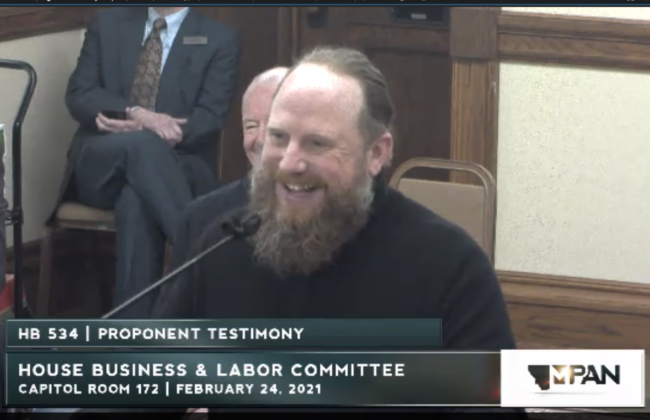
Jeremiah Johnson testifying in support of HB 534
At the hearing, Jeremiah Johnson, owner of Jeremiah Johnson Brewing Company, described the importance of taproom privileges in their business decisions. His brewery currently has a manufacturing operation in Great Falls and a retail operation in Coeur d’Alene, ID, a state with more favorable taproom privileges for brewers.
“In the next 12 to 24 months we will outgrow our production facility in Great Falls, and a significant investment decision will need to be made to support our multi-regional brand. A vital component in our decision making process of where to locate and invest in our new production plant will be the opportunity to include a robust retail operation as a piece of the overall development,” said Johnson.
HB 534 offers a path for additional taproom privileges for breweries within the current licensing system. Brewers are not generally fans of the quota system, but also understand it is the licensing system we have right now. Brewers do not want taproom privileges to continue to be limited due to exclusion from that system. HB 534 is a compromise. It provides a solution for breweries while keeping intact the three-tier system, the quota system, and franchise law (designed to protect distributors from undue influence by a very large brewery).
Though the bill does nothing to directly affect distributors, the Montana Beer and Wine Distributors Association unfortunately opposed HB 534. Their opposition came down to the argument that the bill did not have support of the Montana Alcohol Industry Coalition, where the distributors have blocked proposals to allow brewers to hold a retail license.
During his closing remarks, Sen. Buttrey addressed the opponents’ central argument while pointing out they are not affected by the proposal.
“They talked about how this didn’t come from the coalition, they talked about how bad it was but they didn’t give you any reason why it’s bad.” Buttrey went on to point out that those directly affected by HB 534 are in agreement. “We’ve always said… that we wouldn’t do anything if the parties that were affected didn’t come here in agreement. The parties affected, every one of them, have come here in agreement.”
Based on the hearing and initial responses from legislators, HB 534 looked like it was going to pass out of committee. However, a few factors were working against the bill. The first was time – the bill had just two days remaining to pass out of committee. The next was limited bandwidth – HB 534 was one of 18 bills the committee heard that day, and the committee had many more still to vote on in the coming two days. The last and most potent was controversy.
In the day following the hearing, the distributors offered to withdraw their opposition if they could gain access to the RTD (ready to drink) canned cocktail market. The problem with their proposed compromise is that RTDs are currently distributed through the State Liquor Warehouse and sold through liquor stores in Montana, so giving that privilege to distributors would bring opposition from liquor stores. In the days after the hearing, the conversations on HB 534 focused on the controversial RTD amendment rather than the merits of the bill itself. With limited time and bandwidth, increased controversy proved too much to overcome.
During Friday morning executive action, Rep. Buttrey made a “do pass” motion for HB 534, but Chairman Mark Noland (R-Bigfork) made a substitute motion to table. Those voting yes on the motion to table (and effectively kill the bill) were: Representatives Anderson (R-Great Falls), Duram (R-Eureka), Galloway (R-Great Falls), Gist (R-Cascade), Gunderson (R-Libby), Loge (R-St. Regis), Marshall (R-Hamilton), Noland (R-Bigfork), Olsen (D-Missoula), Seekins-Crowe (R-Billings) and Zolnikov (R-Billings). Those voting against the motion to table (and effectively supporting the bill) were Representatives Abbott (D-Helena), Buttrey (R-Great Falls), Curdy (D-Missoula), Fitzgerald (R-Fairfield), Funk (D-Helena), Harvey (D-Butte), Novak (D-Anaconda), Sullivan (D-Missoula) and Whiteman Pena (D-Lame Deer). The motion to table narrowly passed 11-9.
The bill failed to pass the House before the transmittal deadline, but HB 534 offers hope that the parties can come together and agree on a solution to the longstanding issue of how to achieve additional hours for breweries.
Craft beer in a can has become the norm, but it’s a fairly recent trend. Even 10 years ago bottles were still the go-to package for craft. Cans do have their upsides. They’re lightweight, suitable for outdoor activities like camping and boating, and are more easily recycled than glass, especially in Montana. But we’re in the middle of a can shortage, and that is putting a pinch on craft breweries.
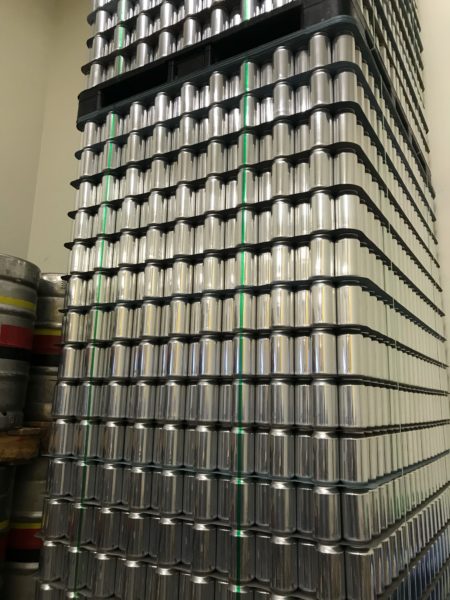
Cans waiting to be filled at Bitter Root Brewing
Last month, Brewers Association President and CEO Bob Pease sent a letter to can manufacturers and the Can Manufacturers Institute requesting immediate allocation of an adequate can supply.
“Our members report that the news on aluminum can supply is worsening, with some allotments representing as much as a 40% reduction in supply,” said Pease. “Some brewers are learning their purchase orders for Q1 deliveries have been canceled. Others are being told that they will not be able to get cans until the second quarter of 2021. These businesses will simply not survive that long without cans.”
There are multiple factors that brought us to this point. Craft brewers have increasingly moved to cans over the past decade. According to the Brewers Association, cans surpassed bottles in 2020 as the package of choice for craft brewers. Beyond craft beer, increased demand for cans has also come from the rise of seltzers (both hard and soft), canned coffees, teas, and other malternative beverages. But the biggest factor is the dramatic market shift from on-premises draught to off-premises package sales due to the pandemic. Consumer habits changed, partially from state and local health rules but also from personal choices to stay home more and go out less. The result has been increased package sales and therefore increased demand for cans.
Can manufacturers are importing more cans and ramping up production capacity to meet demand, but supply is lagging far behind what the industry needs. In the meantime, the craft brewing industry is facing a crisis with an ironic twist. Taproom, bar and restaurant sales are down, while package sales are up, but many brewers are struggling to get the cans they need in order to take advantage of the increased demand for canned beer.
The problem is especially pronounced with 12 ounce cans, both traditional cans and sleeks (those tall skinny versions of 12 ounce cans common with hard seltzers). Tall boys and the 32 ounce cans used for crowlers are easier to come by, but that is little help for breweries whose canning lines, packaging, distribution and shelf space are all geared for 12 ounce cans.
Brewers are getting creative in order to get by. Some are resorting to using cans from seasonal beers that are out of season, slapping labels overtop the pre-printed cans they have in storage. Brewers are also going to secondary suppliers, often with a significant increase in cost.
Bitter Root Brewing was a bit ahead of the curve. They approached their supplier, Berlin Packaging, in late 2020 and found out they were not getting any cans until at least the 4th quarter of 2021, and more likely 2022. The news was bad, but the early warning gave them a chance to secure cans from a third party supplier. Those cans come at a premium, though, costing Bitter Root 70% more than their previous contract with Berlin.
“It’s a tough pill to swallow, but I feel fortunate,” says Jason Goeltz, general manager of Bitter Root Brewing. “Not only do we have the loss of tasting room revenue due to the pandemic, we are also absorbing a 70% material cost increase.”
Flathead Lake Brewing Co. ran into similar challenges and reached out for help. Goeltz was able to connect them with a third party supplier of imported cans which provides a temporary fix. John Hartig, director of brewery operations for Flathead Lake Brewing Co., says those cans are coming at double the cost. They have now received half of their order but have no delivery date for the remaining cans.
“As far as 2021, we planned to satisfy the increased off-premise demand through September,” says Hartig. “After that, we have our fingers crossed that domestic aluminum can production will be back online and meeting demand, or that imported cans will be lower in cost. We plan to do our best to keep shelves full, but if the supply does dry up, we will have no choice but to eliminate certain brands from 12 ounce can packaging.”
Local craft brewers are getting squeezed by a global pandemic coupled with global supply chain challenges. These problems may seem too big and too out of reach for any of us to affect, but consumers can make a difference. The best way to support your local brewery has always been to buy directly from the brewery. The margins are better for the brewery, and there’s no better place to enjoy a pint than right where it’s brewed. With the can shortage, buying directly from the brewery has the added benefit of reducing demand for cans, so the next time you take beer home, choose to stop by your local brewery and fill up a growler.
Montana Brewers Association
P.O. Box 8591
Missoula, MT 59807
406-948-BREW (2739)